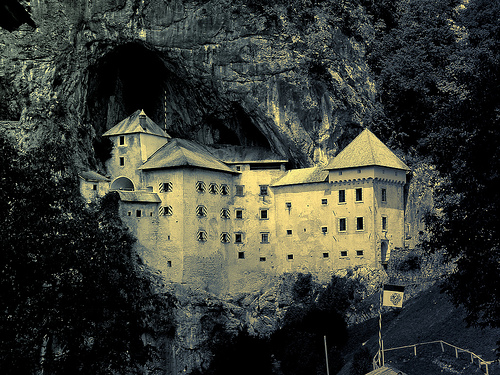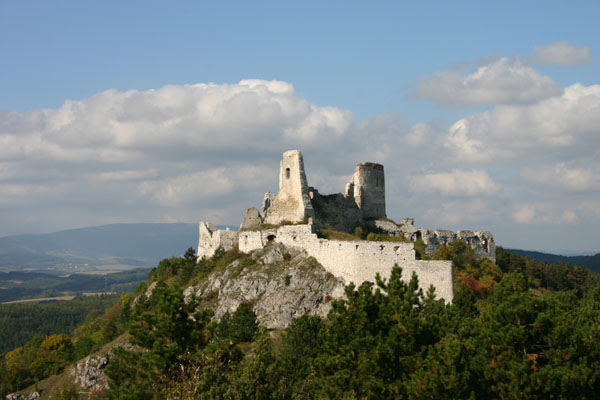Predjama Castle, Slovenia
Ghost Hunters International Visited both these locations in one of their episodes. The castles are amazing. They found proof that Predjama Castle was indeed haunted by getting lots of evps and also a strange figure that appeared on a series of photos.
Predjama Castle, Slovenia
History of the castle
Castle was first mentioned in year 1274, then named Luegg, when Aquileian patriarchs built the castle in gothic style. The castle was built under a natural rocky arch high in the stone wall to make access to it difficult. It was later annexed and re-shaped by family Luegg, also called Predjama knights. Erasmus, who was the owner of the castle in 15th century, and a renowned robber, later joined king Matthias Corvinus, for which the current caesar ordered Gašper Ravbar to assassinate him. After a long siege of the castle, Erasmus was finally killed in 1484 by being tricked. The castle has fallen under Oberburg and Purgstall power.
In year 1567 archduke Karel leased the castle to baron Philipp von Cobenzl, who bought off the castle after 20 years. He annexed the castle as early as 1570 and built a renaissance building, pressed next to a vertical cliff under the castle. The castle remained in such form until today. Count Michael Coronini von Cronberg inherited the castle in 1810 and it was property of family Windischgrätz from 1846 until the end of World War II. After the war it was nationalized and is now used as a museum for showing the life of medieval lords.
A secret natural shaft leads out of the castle, which Erasmus ordered to enlarge, and leads into Postojnska jama. This shaft allowed Erasmus to secretly supply the castle with food in the time of the siege; he also used it to continue with his robberies.
Cachtice Castle, Slovenia
Ghost hunters International didnt find anything at this location that led them to beleive the castle was haunted depsite the unusual and grisly history of it.

The Čachtice Castle (pronounced [t͡ʃaxtʲɪt͡se]) (Slovak: Čachtický hrad, Hungarian: Csejte vára) is a castle ruin in Slovakia next to the village of Čachtice. It stands on a hill featuring rare plants, and has been declared a national nature reserve for this reason. The castle was a residence and later the prison of the Countess Alžbeta (Elizabeth Báthory: 1560-1614) who is alleged to have been the world's most prolific female serial killer.
Čachtice was built in the mid-13th century by Kazimir of the House of Hunt-Poznan as a sentry on the road to Moravia. Later, it belonged to Matthew Csák, the Stibor family, and then to the famous Bloody Lady Elizabeth Báthory. Čachtice, its surrounding lands and villages, was a wedding gift from the Nádasdy family upon Elizabeth's marriage to Ferenc Nádasdy in 1575.
Originally, Čachtice was a Romanesque castle with an interesting horseshoe shaped residence tower. It was turned to a Gothic castle later and its size was increased in the 15th and 16th centuries. A Renaissance renovation followed in the 17th century. Finally, in 1708 the castle was captured and plundered by the rebels of Francis II Rákóczi.
Elizabeth Báthory
Countess Elizabeth Báthory (Báthory Erzsébet in Hungarian, Alžbeta Bátoriová in Slovak, Alžběta Báthoryová in Czech, Elżbieta Batory in Polish, August 7, 1560 �?August 21, 1614), was a Hungarian countess from the renowned Báthory family. She is possibly the most prolific serial killer in history and is remembered as the "Blood Countess" and as Bloody Lady of Čachtice, after the castle near Trenčín, at that time in Royal Hungary, where she spent most of her life.
She spent most of her adult life at Čachtice Castle in what is now Slovakia. The Báthory family is famous for defending Hungary against the Ottoman Turks.
After her husband's death, she and four collaborators were accused of torturing and killing hundreds of girls and young women, with one witness attributing to them over 600 victims, though she was only convicted on 80 counts.[1] In 1610, she was imprisoned in Čachtice Castle, where she remained bricked in her room until her death four years later. She was never formally tried in court.
This spread the story of the Countess bathing in the blood of virgins in order to retain her youth. These stories have led to comparisons with Vlad III the Impaler of Wallachia, on whom the fictional Count Dracula is partly based, and to modern nicknames of the Blood Countess.
Information from From Wikipedia, the free encyclopedia - thankyou!!!!!!
 Free Forum Hosting
Free Forum Hosting